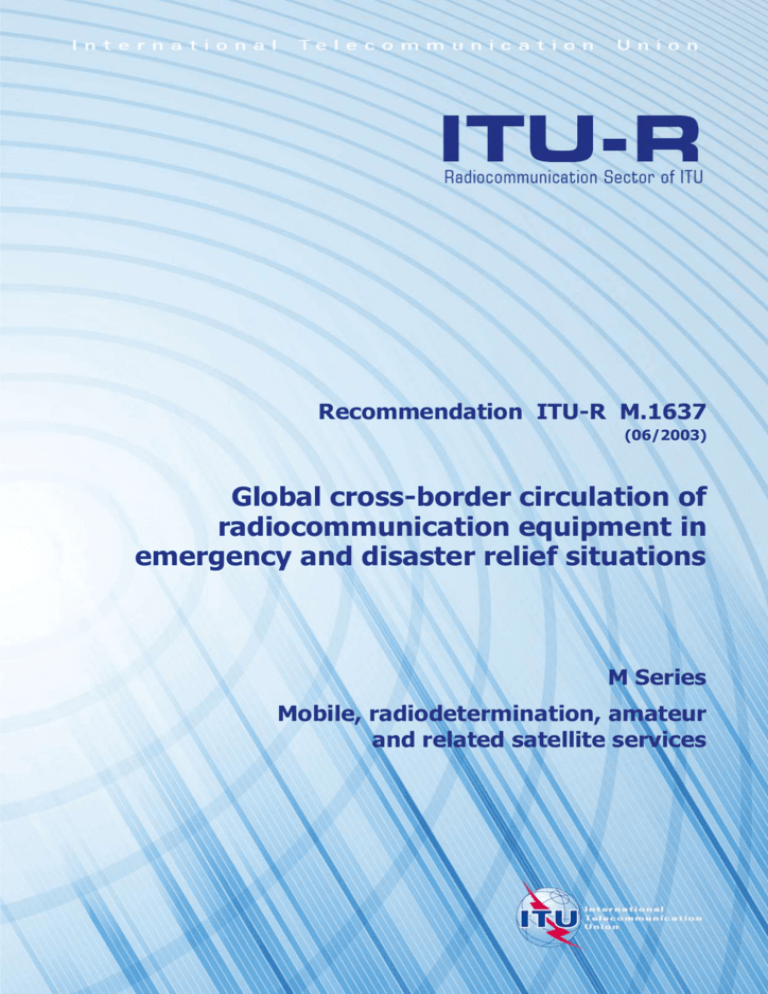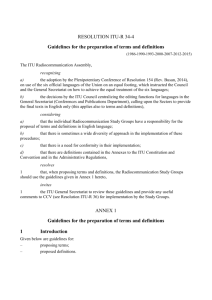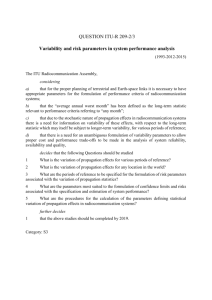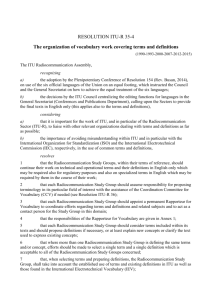
Recommendation ITU-R M.1637
(06/2003)
Global cross-border circulation of
radiocommunication equipment in
emergency and disaster relief situations
M Series
Mobile, radiodetermination, amateur
and related satellite services
ii
Rec. ITU-R M.1637
Foreword
The role of the Radiocommunication Sector is to ensure the rational, equitable, efficient and economical use of the
radio-frequency spectrum by all radiocommunication services, including satellite services, and carry out studies without
limit of frequency range on the basis of which Recommendations are adopted.
The regulatory and policy functions of the Radiocommunication Sector are performed by World and Regional
Radiocommunication Conferences and Radiocommunication Assemblies supported by Study Groups.
Policy on Intellectual Property Right (IPR)
ITU-R policy on IPR is described in the Common Patent Policy for ITU-T/ITU-R/ISO/IEC referenced in Annex 1 of
Resolution ITU-R 1. Forms to be used for the submission of patent statements and licensing declarations by patent
holders are available from http://www.itu.int/ITU-R/go/patents/en where the Guidelines for Implementation of the
Common Patent Policy for ITU-T/ITU-R/ISO/IEC and the ITU-R patent information database can also be found.
Series of ITU-R Recommendations
(Also available online at http://www.itu.int/publ/R-REC/en)
Series
BO
BR
BS
BT
F
M
P
RA
RS
S
SA
SF
SM
SNG
TF
V
Title
Satellite delivery
Recording for production, archival and play-out; film for television
Broadcasting service (sound)
Broadcasting service (television)
Fixed service
Mobile, radiodetermination, amateur and related satellite services
Radiowave propagation
Radio astronomy
Remote sensing systems
Fixed-satellite service
Space applications and meteorology
Frequency sharing and coordination between fixed-satellite and fixed service systems
Spectrum management
Satellite news gathering
Time signals and frequency standards emissions
Vocabulary and related subjects
Note: This ITU-R Recommendation was approved in English under the procedure detailed in Resolution ITU-R 1.
Electronic Publication
Geneva, 2010
ITU 2010
All rights reserved. No part of this publication may be reproduced, by any means whatsoever, without written permission of ITU.
Rec. ITU-R M.1637
1
RECOMMENDATION ITU-R M.1637*
Global cross-border circulation of radiocommunication equipment
in emergency and disaster relief situations
(2003)
Scope
This Recommendation addresses issues to be considered in order to facilitate the global circulation of
radiocommunications equipment to be used in emergency and disaster relief situations.
The ITU Radiocommunication Assembly,
considering
a)
that public protection radiocommunication is radiocommunication used by responsible
agencies and organizations dealing with maintenance of law and order, protection of life and
property, and emergency situations;
b)
that disaster relief radiocommunication is radiocommunication used by agencies and
organizations dealing with a serious disruption of the functioning of society, posing a significant,
widespread threat to human life, health, property or the environment, whether caused by accident,
nature or human activity, and whether developing suddenly or as the result of complex, long-term
processes;
c)
that disaster relief operations have evolved over the years to make use of
radiocommunication systems as a reliable and effective means of communication for the crucial
success of the disaster relief operation;
d)
that many international disaster relief organizations utilize telecommunication networks for
coordinating their efforts and for linking to authorities and affected persons when providing
emergency care;
e)
that providers of international humanitarian assistance employ and depend on
non-dedicated radiocommunication equipment which is widely in use and available, including
amateur radio and mobile portable satellite facilities for their telecommunications during
international disaster relief operations;
f)
that disaster relief users have operational requirements that may differ from other wireless
users;
g)
that the importation and circulation of radiocommunication equipment is usually required
when the local telecommunication infrastructure is damaged, overloaded or non-existent in the area
of the disaster;
h)
*
that when an emergency or disaster occurs, the speed of the response is critical;
Radiocommunication Study Group 5 made editorial amendments to this Recommendation in 2008 in
accordance with Resolution ITU-R 44.
Rec. ITU-R M.1637
2
j)
that the efforts of emergency and disaster relief workers are often delayed by a number of
factors which may include actions by some administrations that:
restrict or prohibit the import and use of radiocommunication equipment;
have lengthy and/or costly immigration and customs procedures;
lack an expedient process for the authorization to operate radiocommunication equipment
or for the permission to use radiocommunication equipment in border areas;
insist on the use of certain types of fixed frequency radios making it technically difficult to
operate in changing situations,
noting
a)
that national and regional authorities should, when possible, and in conformity with their
national laws, cooperate in order to reduce and remove any obstacles hindering global cross-border
circulation of radiocommunication equipment intended for use in emergency and disaster relief
situations, particularly to:
develop agreements and regulations intended for use in emergency and disaster relief
situations from all import, export and transit duties,
recognizing
a)
that Resolution 645 (WRC-2000) invites ITU-R to conduct studies for development of a
Resolution concerning the technical and operational bases for global cross-border circulation of
radiocommunication equipment in emergency and disaster relief situations;
b)
that the World Customs Organization (WCO) has developed two international agreements
which are applicable to radiocommunication equipment intended for disaster relief operations:
the Istanbul Convention, which binds countries to eliminating customs duties on personal
effects and professional equipment carried by visitors;
the Professional Equipment Convention, which has so far been adopted by about
40 countries, which exempts from customs duties equipment used by professionals,
e.g. journalists, doctors, relief workers, businessmen, etc.;
c)
that the United Nations Office for the Coordination of Humanitarian Affairs (UN-OCHA)
which has the mandate to coordinate international humanitarian assistance, disaster relief and
disaster mitigation convenes the Working Group on Emergency Telecommunications (WGET),
an inter-agency forum of entities concerned with humanitarian assistance;
d)
that WGET is following up on potential applications of Resolution 645 (WRC-2000) to
deal with regulatory issues, specifically regarding the trans-border use of telecommunication
equipment during acute emergencies;
e)
that the Istanbul Declaration of WTDC-02 included among a number of pressing issues, the
importance of emergency telecommunications;
f)
that the 1998 Intergovernmental Conference on Emergency Telecommunications
(ICET-98), with the participation of 76 countries and various intergovernmental and
non-governmental organizations, adopted the Tampere Convention on the Provision of
Telecommunication Resources for Disaster Mitigation and Relief Operations. In 1998, 33 States
signed this comprehensive Convention which also contains an article dealing with the removal of
regulatory barriers. Thirty ratifications or definitive signatures are needed by June 2003 for entry in
force;
Rec. ITU-R M.1637
3
g)
that the World Radiocommunication Conference (Istanbul, 2000), has revisited
Resolution 644 (Rev.WRC-2000) which:
urges administrations to take all practical steps to facilitate the rapid deployment and
effective use of telecommunication resources for disaster mitigation and disaster relief
operations by reducing and where possible removing regulatory barriers and strengthening
trans-border cooperation between States;
invites the ITU-R to continue to study, as a matter of urgency, those aspects of
radiocommunications that are relevant to disaster mitigation and relief operations;
h)
that the Information Technology Agreement (ITA) of the World Trade Organization
(WTO) aims at eliminating import duties on all information technology equipment including
wireless terminals and equipment;
j)
that administrative arrangements for circulation should be aimed at simplifying existing
regulation;
k)
that inter-administration measures facilitating cross-border use of radio equipment exist in
some cases,
recommends
1
that, when discussing circulation of any radiocommunication equipment for emergency and
disaster relief situations, present needs as well as future and advanced solutions should be taken into
account;
2
that, in order to facilitate a speedy authorization process for the operation of
radiocommunication equipment in emergency and disaster relief situations, the regulatory
authorities are encouraged to develop plans and rules in place before a possible disaster that:
facilitate the operation of radiocommunication equipment by visiting personnel in the
territory of the disaster/emergency;
facilitate the use of radiocommunication equipment that such organizations employ;
take into account, as appropriate, the frequencies of the radiocommunication equipment that
will be used by such organizations;
3
that, in order to establish the technical basis for global circulation of radiocommunication
equipment in emergency and disaster relief situations, such equipment needs to fulfill the
requirement for avoiding harmful interference in any country where they circulate:
by conforming to ITU-R Recommendations, particularly with regard to emission limits.






